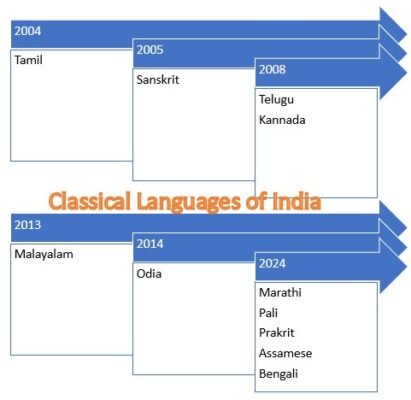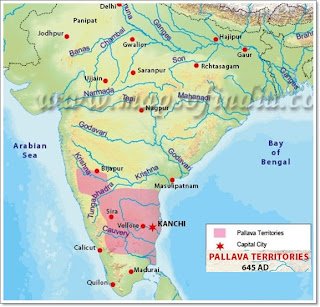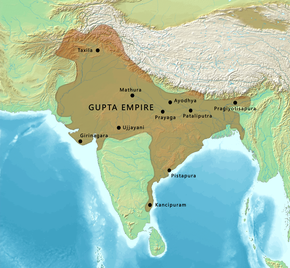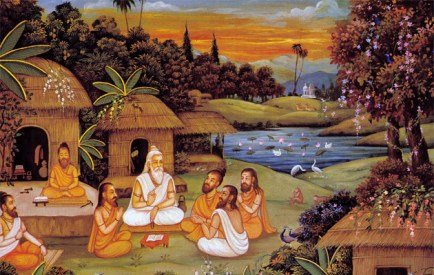Art & Culture
latest posts
Q. Examine the role of the Maha Kumbh 2025 in promoting interfaith harmony and showcasing India’s pluralistic cultural fabric.
The Maha Kumbh Mela, scheduled for 2025 in Prayagraj, is one of the largest religious [...]
read moreApr
Q. Identify the benefits of recognizing any language as a classical language. State the bases of it’s recognition.
The Classical Languages serve as a custodian of Bharat’s profound and ancient cultural heritage, embodying [...]
read moreOct
Q.11. “Though the great Cholas are no more yet their name is still remembered with great pride because of their highest achievements in the domain of art and architecture.” Comment. [UPSC 2024 GS P-1]
The Cholas, one of the greatest dynasties of South India, left an indelible mark on [...]
read moreQ.2. Estimate the contribution of Pallavas of Kanchi for the development of art and literature of South India. [UPSC 2024 GS P-1]
The Pallavas of Kanchi made significant contributions to the development of art and literature in [...]
read moreSep
The Tirupati Laddu controversy
The Tirupati Laddu, a sacred offering at the Tirumala Tirupati Devasthanams (TTD), has a rich [...]
read moreSep
Q.1. How will you explain that medieval Indian temple sculptures represent the social life of those days? [UPSC 2022 GS P-1]
Medieval Indian temple sculptures offer a vivid portrayal of the social life of their time, [...]
read moreQ. “The Gupta Age is often referred to as the Golden Age of ancient India.” Why?
Introduction to the Gupta Era: The Gupta Empire emerged on the ruins of the Kushan [...]
read moreMay
Q. Discuss the urban planning and architecture of the Harappan Civilization. How does it reflect the socio-economic conditions of that time?
The urban planning and architecture of the Harappan Civilization, also known as the Indus Valley [...]
read moreMay
Q.11. What are the main features of Vedic society and religion? Do you think some of the features are still prevailing in Indian Society? [UPSC 2023 GS P-1]
The Vedic period, spanning from 1500 to 600 BCE, was a significant era in ancient [...]
read moreMay
Q.13. What were those reasons because of which Buddhism flourished more than the Jainism?
Buddhism and Jainism are two ancient Indian religions that have their roots in the Magadha [...]
read moreQ.12. Examine the challenges faced by Buddhism and Jainism in contemporary India.
Buddhism and Jainism, while integral to India’s religious diversity, face several challenges in contemporary society: [...]
read moreQ.11. Analyze the impact of Buddhism and Jainism on social reform movements in India.
Buddhism and Jainism have played a significant role in social reform movements in India, influencing [...]
read moreQ.10. Discuss the contributions of prominent Buddhist and Jain scholars and leaders to Indian society.
Prominent Buddhist and Jain scholars and leaders have made significant contributions to Indian society in [...]
read moreQ.9. Evaluate the influence of Buddhism and Jainism on Indian literature, philosophy, and ethics.
Buddhism and Jainism have had a significant influence on Indian literature, philosophy, and ethics, shaping [...]
read moreQ.8. Explain the concept of nirvana in Buddhism and its significance for spiritual liberation.
The concept of nirvana in Buddhism is the ultimate goal of the Buddhist path and signifies the [...]
read moreQ.7. Discuss the principles of non-violence (ahimsa) in Jainism and its ethical implications.
The principle of non-violence, or ahimsa, is the cornerstone of Jain philosophy and ethics. It extends beyond [...]
read moreQ.6. Evaluate the impact of Buddhist and Jain art and architecture on Indian culture.
Buddhist and Jain art and architecture have had a profound impact on Indian culture, each [...]
read moreQ.5. What were the key differences between Buddhist and Jain views on women?
The key differences between Buddhist and Jain views on women primarily revolve around their religious [...]
read moreQ.4. Explain the concept of karma and its significance in Jainism.
In Jainism, karma is not merely a philosophical concept but a real substance that pervades [...]
read moreQ.3. Compare and contrast the fundamental beliefs and practices of Buddhism and Jainism.
Buddhism and Jainism are two ancient Indian religions that, while sharing some similarities, have distinct [...]
read moreQ.2. Analyze the contributions of Emperor Ashoka to the spread of Buddhism.
Emperor Ashoka’s contributions to the spread of Buddhism were monumental and multifaceted. Here’s an analysis [...]
read moreQ.1. Discuss the core teachings of Buddhism and their relevance in the modern world.
The core teachings of Buddhism are centered around the Four Noble Truths and the Eightfold Path: The Four [...]
read more







